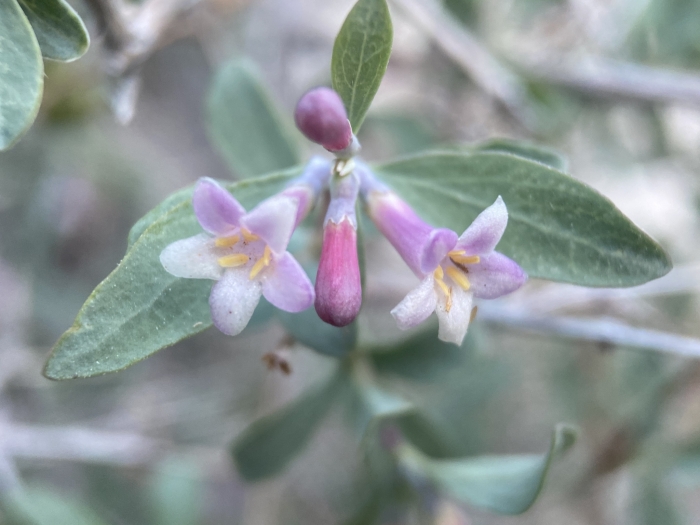Desert Snowberry
(Symphoricarpos longiflorus)
Desert Snowberry (Symphoricarpos longiflorus)
/
/

Matt Berger
CC BY 4.0
Image By:
Matt Berger
Recorded By:
Copyright:
CC BY 4.0
Copyright Notice:
Photo by: Matt Berger | License Type: CC BY 4.0 | License URL: http://creativecommons.org/licenses/by/4.0/ | Rights Holder: Matt Berger | Publisher: iNaturalist | Date Created: 2020-06-06T02:26:10Z |























Estimated Native Range
Summary
Symphoricarpos longiflorus, commonly known as Desert Snowberry, is a deciduous shrub native to chaparral, desert scrub, and open woodlands of the Southern Intermountain regions of the USA and Baja California. It belongs to the honeysuckle family and is adapted to dry, rocky environments. This shrub typically reaches up to 1 meter (40 inches) in height and has an erect, spreading habit with stiff branches. The leaves are small, oval, and blue-green, providing a backdrop for the fragrant flowers that appear from late spring to early summer. Flowers are tubular with a long throat up to 1.5 centimeters (0.6 inch) long, flaring into five pointed lobes, usually white to pale pink in color. After flowering, it produces small, white to pale pink berries that are attractive to wildlife.
Desert Snowberry is valued for its drought tolerance and wildlife-friendly berries. It is suitable for xeriscaping, naturalistic plantings, and as a component of wildlife gardens. It thrives in full sun to part shade and requires well-drained soils, tolerating a range of soil types from sandy to loamy. While it is relatively low-maintenance, it benefits from occasional pruning to maintain its shape and promote denser growth. It is not commonly afflicted by diseases but can suffer from root rot in poorly drained soils.CC BY-SA 4.0
Desert Snowberry is valued for its drought tolerance and wildlife-friendly berries. It is suitable for xeriscaping, naturalistic plantings, and as a component of wildlife gardens. It thrives in full sun to part shade and requires well-drained soils, tolerating a range of soil types from sandy to loamy. While it is relatively low-maintenance, it benefits from occasional pruning to maintain its shape and promote denser growth. It is not commonly afflicted by diseases but can suffer from root rot in poorly drained soils.CC BY-SA 4.0
Plant Description
- Plant Type: Shrub
- Height: 1.5-3 feet
- Width: 1.5-3 feet
- Growth Rate: Moderate
- Flower Color: Pink, White
- Flowering Season: Spring, Summer, Fall
- Leaf Retention: Deciduous
Growth Requirements
- Sun: Full Sun, Part Shade
- Water: Medium
- Drainage: Fast
Common Uses
Bee Garden, Bird Garden, Butterfly Garden, Erosion Control, Hummingbird Garden, Low Maintenance, Showy Flowers
Natural Habitat
Native to chaparral, desert scrub, and open woodlands of the Southern Intermountain regions of the USA and Baja California
Other Names
Common Names: Fragrant Snowberry , Longleaf Snowberry
Scientific Names: Symphoricarpos longiflorus , Symphoricarpos fragrans
GBIF Accepted Name: Symphoricarpos longiflorus A.Gray